Beakery!
A site where I can beak off about whatever comes to mind…
Monthly Archives: December 2012
After the apocalypse
Posted by on December 23, 2012
A man should have wings to carry him where his dreams go but sometimes a pair of skis makes a good substitute
Hans Gmoser, 1932-2006
The day after the Mayan Apocalypse, I went backcountry skiing.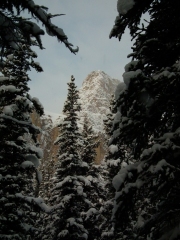
Old tracks graced the parking lot, and old tracks graced the trail. The recent snow over the past few days had started the long process of masking the old marks of people, and it almost felt sacrilegious to slow down the erasure of human activity. But I knew, too, that it would only be temporary. The snow was still drifting down, and given time my tracks too would be erased.
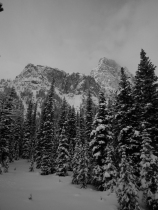 My destination was Tower Lake and, if conditions permitted, Rockbound Lake behind the towering precipice of Castle Mountain. It’s a fair distance – about 8 km to the lakes – and skiing is necessarily slower than walking on dry ground. Or at least it is when going up. And despite the initially cold temperatures, I was soon sweating my way up through the forest.
My destination was Tower Lake and, if conditions permitted, Rockbound Lake behind the towering precipice of Castle Mountain. It’s a fair distance – about 8 km to the lakes – and skiing is necessarily slower than walking on dry ground. Or at least it is when going up. And despite the initially cold temperatures, I was soon sweating my way up through the forest.
Many skiers would despair of such a trip. I had no plans to ski any slopes, as I was entirely by myself. And without the prospect of powder, why bother making such a trip? It’s a hard question to answer in words, but the answer is obvious when you’re travelling through the still forest. When the world is muffled by a layer of pristine snow and the only sound is the swish of your skis and the panting of your lungs the answer is obvious. When you break out into a meadow without a single shred of evidence of other life, and you stop to listen to the world and it is so quiet that the only sound you hear is a slight ringing in your ears, the answer is obvious. I need no apocalypse to wipe away humanity: I need only point myself towards the mountains and go. I am truly fortunate to have such places so close to where I live. I pity those who do not have the opportunity to travel – simply – through a snow covered forest, and I pity even more those who cannot understand why one would do so. The sense of peace it brings is indescribable. 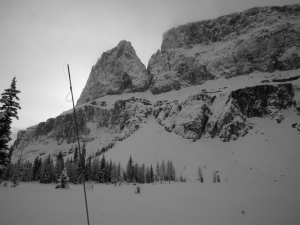
Take some time this winter, and go embrace the cold and the snow. Leave your living room, leave your kitchen, leave the warmth of the inside. Escape into a world where the snow gently falls onto an untrammeled landscape, where the silence is disconcerting in its entirety, where evidence of your passing will soon be wiped away and it will be as though you had never existed.
Go find yourself again.
The immensity of human ingenuity
Posted by on December 14, 2012

The Narada
I just recently re-watched the 2009 remake of Star Trek, and while I could probably fill an entire post and then some regarding all the plot holes and inconsistencies, I realized that the scenes that I appreciated the most were those that showed off the true scale of engineering and architecture that would be available to a civilization capable of advanced space travel. Or, put another way, it shows the scale of engineering that would be necessary to achieve and sustain advanced space travel. As one concrete, and very obvious, example from the movie, consider Nero’s ship, the Narada. We get to see it in relation to other spaceships, notably the Kelvin and the Enterprise, and by comparison it is mind-boggling enormous. The Enterprise itself is about 330 m long, or 1000 ft; this is about the same length as a Nimitz-class aircraft carrier. I have had the opportunity to be on an aircraft carrier once: the USS Midway in San Diego, and at a length of 296 m it is still an enormous piece of machinery. However, in Star Trek the Narada is a staggering 10 km long. It would take over two hours to walk the length of the vessel. The engineering challenges involved in constructing a vessel of that size are enormous. Simply powering such a ship would require fantastical amounts of energy. The intellectual effort that would have gone into the design and construction of the Narada is almost beyond imagination.
And yet someone did imagine the design, and imagine that it could be constructed.
One of my favourite shots in the movie is where the construction yard for the Enterprise is shown among the farms of Iowa.
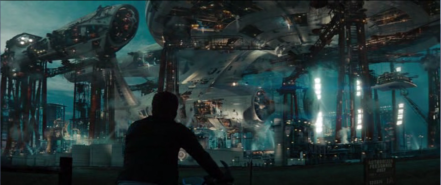
The Enterprise during construction.
It is hard to see the scale of objects in space, because space is so immensely vast. And yet among the fields of Iowa, and with the Enterprise in its unfinished state with people working on it, one can actually get a grasp on the scope of engineering that is needed to construct a vessel of that size and complexity. And maybe the scene is all the more powerful because in it we have high technology juxtaposed with simple technology; that is to say, farming. We can see the progression of human inventiveness across the ages in a single setting.
Why am I so drawn to this imagery? For me, at least, I am astounded at the scope of human imagination and vision. In such imagery, I get to see the true grandeur of human ingenuity – even if it is only fiction. And Star Trek isn’t the only place where I get to see this kind of imagery. I also recently watched The Hitchhiker’s Guide to the Galaxy (and promptly spent the next week laughing over the original radio series) and my favourite visual scene is when Arthur Dent and Slartibartfast first enter the “factory floor” of the Magrathean planet-building operation. There, engineering is scaled up to its full potential and almost defies Nature itself. Perhaps that’s why I am so drawn to imagery of designs of such immense scale – it is a refutation of some internal pessimism that says that “we can’t do that.”
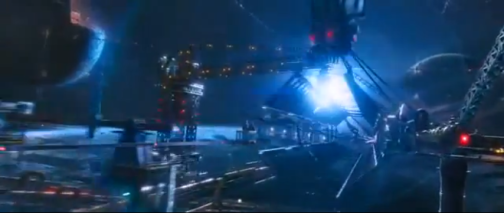
The Magrathean factory floor.
Projects on vast scales remind us that we are small and insignificant, but also that we can build such marvels, or at least we will – the first step is always imagining. And because we can, we can also control our fate in the universe, and make it a paradise if we wish.
Interestingly, I think that I am drawn to imagery of natural beauty on vast scales for a similar reason: it makes me feel puny and insignificant compared to the achievements of the natural world. It’s a reminder of how frail we are. It serves as inspiration for scope and as a reminder that mindless forces can create immense works of art – just as mindful forces can.
I don’t think that I am alone in this fascination. Why are most people drawn to the mountains or the canyons or the oceans? They make us feel small. They remind us of our insignificance. And why do we build engineering and artistic marvels that surpass our imaginations? Why build skyscrapers like the Burj Dubai, or cathedrals like the Notre Dame in Paris? They remind us of our ability to shape our own fate. And because of their size, there are immensely powerful reminders.
In closing, I will point out that the physically largest accomplishments are simply the most obvious reminders of our ingenuity. One invention that continually captures my sense of wonder and amazement is ubiquitous, and it is sitting on my lap right now: the computer. Try and wrap your head around the complexity of the modern computer, and I think you’ll agree with me that it’s hard to imagine that humanity could have ever invented such a device.
And yet we did.
What lies in the future for us to discover, invent, engineer? I can’t wait to see.